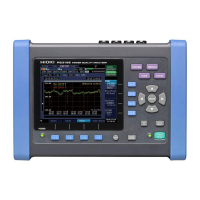4 5
Application use
PQ3198 PQ3100 PW3360-21 PW3365 CM3286-01
Energy audit and power survey Advanced Standard
Measure V, I, P, kW, PF/DPF, kWh
Conduct power and energy surveys to understand the power consumption and validate energy saving
✓ ✓ ✓ ✓ ✓
Measure MIN/MAX and AVG values
✓ ✓ ✓ ✓ ✓
Voltage, current and power trend recording
✓ ✓ ✓ ✓
‒
Energy cost measurement ‒
✓ ✓ ✓
‒
Basic harmonics measurement
THD measurement (V & I)
This value can be monitored to assess waveform distortion for each item, providing a yardstick that indicates the
extent to which the total harmonic components are distorting the fundamental waveform
✓ ✓ ✓ ✓ ✓
Harmonics 1 to 30 for V & I
When the level of the harmonic component is high, it may cause serious accidents such as overheating or noise in
motors or transformers, and burn out reactors in phase compensation capacitors.
✓ ✓ ✓ (1-40.PW3360-21) ✓ (1-13) ✓
Advanced harmonics measurement
Harmonics 0 to 50 for V & I
When the level of the harmonic component is high, it may cause serious accidents such as overheating or noise in
motors or transformers, and burn out reactors in phase compensation capacitors.
Detect the DC element on the AC circuit (0th order).
✓ ✓
‒ ‒ ‒
High order harmonics 2 kHz to 80 kHz
High-order harmonic components can damage equipment and power supplies, cause equipment operation to be
reset, or result in abnormal sound from TVs and radios.
✓
‒ ‒ ‒ ‒
Inter-harmonics
Inter-harmonics are caused when the voltage or current waveform is distorted due to static frequency conversion
equipment, cycloconverters, Scheribus drive, induction motors, welders, or arc furnaces. The term refers to fre-
quency components that are not a whole multiple of the fundamental wave.
✓ ✓
‒ ‒ ‒
Power harmonics
Detect the harmonics direction
✓ ✓ ✓ (PW3360-21)
‒ ‒
Standard power quality troubleshooting
Detailed trend recording for V and I
For conducting power surveys to understand the current power quality status
✓ ✓
‒ ‒ ‒
Power quality event recording
Measurement according to the EN50160 standard includes transient, swell, dip, interruption, frequency (200 ms)
and icker.
✓ ✓
‒ ‒ ‒
Advanced power quality troubleshooting
Detect multiple events simultaneously
Multiple events may occur for a single power quality problem. Detecting them simultaneously may help you
pinpoint the cause.
✓ ✓
‒ ‒ ‒
High speed sampling for transient measurement
Measure the duration and peak voltage of the transient event to determine the power quality problem
✓
‒ ‒ ‒ ‒
Advanced Features
Anti-theft detection
Compare the measurement values with the electric meter measurement to detect the differences
‒ ‒ ‒ ‒
✓
Frequency uctuation
Frequency fluctuation occurs due to line separation caused by circuit issues, shutdown of a high-capacity
generators, or changes in the supply/demand balance of active power.
✓ ✓
‒ ‒ ‒
Transient voltage (impulse)
Transient voltage occurs due to phenomena such as lightning, breaker damage, or closure of the circuit breaker
or relay. It often occurs when there is a radical change in voltage or when the peak voltage is high.
✓ ✓
‒ ‒ ‒
Voltage dip (SAG)
Most dips are caused by natural phenomena such as lightning. When an equipment fault is detected and taken
ofine due to the occurrence of a power system ground fault or short-circuit, a large inrush current caused by a
motor startup or another load can occur, causing a temporary voltage dip.
✓ ✓
‒ ‒ ‒
Voltage swell (SURGE)
Swells occur when the voltage rises momentarily. Some examples of these are when a power line turns on or
off due to lightning or a heavy load, when a high-capacity capacitor bank is switched, when a one-line ground
occurs, and when a high-capacity load is cut off. This phenomenon also includes voltage surges due to grid-tied
dispersed power supplies (e.g. solar power).
✓ ✓
‒ ‒ ‒
Flicker
Flicker consists of voltage uctuations resulting from causes such as blast furnaces, arc welding, and thyristor
control loads. Manifestations include light bulb ickering.
✓ ✓
‒ ‒ ‒
Interruption (momentary power outage)
Interruptions consist of momentary, short-term, or extended power supply outages as a result of factors such
as circuit breakers being tripped due primarily to power company issues (interruption of power due to lightning
strikes, etc.) or power supply short-circuits.
✓ ✓
‒ ‒ ‒
Unbalance
Unbalance is caused by increases or decreases in the load connected to each phase of a power line, distortions
in voltage and current waveforms, voltage dips, or negative phase voltage caused by the operation of equipment
or devices that run with uneven power supply to load.
✓ ✓
‒ ‒ ‒
Inrush current
Inrush current is a large current that ows momentarily, for example when electric equipment is turned on.
✓ ✓
‒ ‒ ‒
DC measurement
Measurement for DC loads or systems
✓ ✓
‒ ‒ ‒
400 Hz measurement
Power measurement for aviation systems and shipboard systems
✓
‒ ‒ ‒ ‒
Power inverter/converter efciency
Measure the primary side and secondary side of power of inverters or converters to evaluate the system efciency.
✓
‒ ‒ ‒ ‒
GPS time synchronization
GPS time synchronization eliminates any time difference between instruments. It allows analysis that preserves the
simultaneity of phenomena measured with multiple instruments.
✓
‒ ‒ ‒ ‒
Interface
USB
✓ ✓ ✓ ✓
‒
Ethernet
✓ ✓ ✓ ✓
‒
Bluetooth connectivity ‒ ‒ ‒ ‒
✓
SD card
✓ ✓ ✓ ✓
‒
RS-232C
✓ ✓
‒ ‒ ‒
Pulse
✓ (Event input function) ✓ (Event input function) ✓ (Pulse I/O terminals)
‒ ‒
Safety 600 V (CAT IV)
600 V (CAT IV),
1000 V (CAT III)
600 V (CAT III) 600 V (CAT III) 600 V (CAT IV)
Non-metallic contact power measurement
‒ ‒ ‒
✓
‒
Power from measurement line
‒ ‒
✓
‒ ‒
Products comparison

